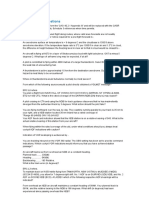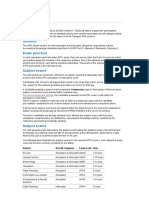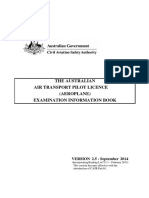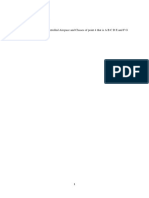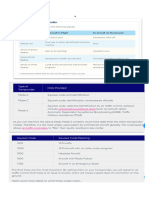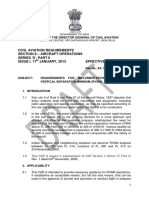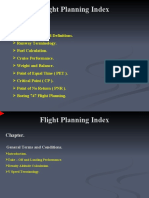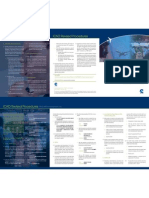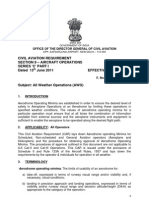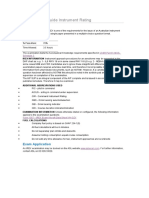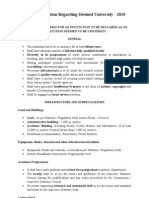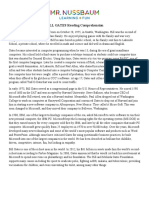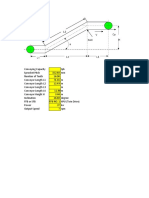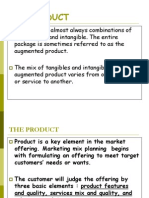Civil Aviation Amendment Order (No. R9) 2004 As Amended
Civil Aviation Amendment Order (No. R9) 2004 As Amended
Uploaded by
greg mCopyright:
Available Formats
Civil Aviation Amendment Order (No. R9) 2004 As Amended
Civil Aviation Amendment Order (No. R9) 2004 As Amended
Uploaded by
greg mOriginal Description:
Original Title
Copyright
Available Formats
Share this document
Did you find this document useful?
Is this content inappropriate?
Copyright:
Available Formats
Civil Aviation Amendment Order (No. R9) 2004 As Amended
Civil Aviation Amendment Order (No. R9) 2004 As Amended
Uploaded by
greg mCopyright:
Available Formats
Civil Aviation Amendment Order (No.
R9) 2004
as amended
made under subregulation 235 (2) of the Civil Aviation Regulations 1988.
This compilation was prepared on 7 October 2014 taking into account amendments up
to Civil Aviation Order 20.7.4 Amendment Instrument 2014 (No. 1).
Prepared by the Legislative Drafting Section, Legal Branch, Legal Services Division,
Civil Aviation Safety Authority, Canberra.
1
Name of Order
This Order is the Civil Aviation Amendment Order (No. R9) 2004.
Commencement
This Order commences on gazettal.
Replacement of section 20.7.4 of the Civil Aviation Orders
Section 20.7.4 of the Civil Aviation Orders is omitted and a new section
substituted as set out in Schedule 1.
Schedule 1
Substitution of section 20.7.4 of the Civil Aviation
Orders
Section 20.7.4
Aeroplane weight and performance limitations aeroplanes not above
5 700 kg private, aerial work (excluding agricultural) and charter
operations
2
Application
Unless CASA specifies that Civil Aviation Order 20.7.1 or 20.7.2 is to be
applied, this section applies to:
(a) propeller-driven aeroplanes having a maximum take-off weight not in
excess of 5 700 kg; and
(b) jet-engined aeroplanes having a maximum take-off weight not in excess
of 2 722 kg;
that are engaged in regular public transport operations (single engine
aeroplanes only), private operations, aerial work operations (excluding
agricultural operations) and charter operations.
Definitions
In this section:
aircraft landing area means an area of land suitable for use for the landing or
take-off of aircraft.
3.1
1
Federal Register of Legislative Instruments F2014C01367
Civil Aviation Amendment Order (No. R9) 2004
approved foreign flight manual, in relation to an aeroplane, means the flight
manual approved by the relevant regulatory aviation authority of the country
where the aeroplane is, or was, manufactured.
landing distance available means the distance specified by CASA as being
the effective operational length available for use by aircraft for landing at
certified or registered aerodromes or the distance available for landing on an
aircraft landing area.
manufacturers data manual, in relation to an aeroplane, means a publication
(however described) produced by the manufacturer of the aeroplane as a guide
for the flight crew in the operation of the aeroplane.
pressure height means the height registered on an altimeter with the sub-scale
set to 1013.2 hPa.
take-off safety speed means the speed specified on the aeroplane take-off
chart being the minimum speed to which an aeroplane must be accelerated in
establishing the take-off distance required.
take-off distance available means the distance specified by CASA as being
the effective operational length available for use by aircraft for take-off at
certified or registered aerodromes or the distance available for take-off on an
aircraft landing area.
VS is the symbol used to denote the minimum speed in a stall or the minimum
steady flight speed in the aeroplane configuration in which VS is being used.
4
4.1
5
5.1
Take-off weight limitations
An aeroplane must not take off at a weight in excess of the least of the weights
determined in accordance with subparagraphs (a) to (d):
(a) a weight at which the take-off distance required under subsection 6 for
the pressure height, temperature, runway slope (if in excess of 1%) and
wind component along the runway, is equal to or less than the take-off
distance available in the direction of take-off. Approved declared
conditions may be used instead of actual pressure height and temperature;
(b) a weight which will permit compliance with the take-off climb
requirements specified in subsection 7 taking into account ambient
temperature and pressure height. Approved declared temperature and
pressure height may be used instead of ambient conditions;
(c) a weight which will permit compliance with the en-route climb
requirements specified in subsection 8;
(d) a weight which, allowing for normal consumption of fuel and oil in flight
and taking into account either the forecast temperature and pressure or
approved declared conditions, will permit compliance with the landing
distance limitations specified in subsection 10 related to the longest
available landing length under conditions of zero wind.
Landing weight limitations
Except in an emergency, an aeroplane must not land at a weight in excess of
the least of the weights determined in accordance with subparagraphs (a) and
(b):
(a) a weight at which the landing distance required in accordance with
subsection 10 for the pressure height, temperature, runway slope (if in
2
Federal Register of Legislative Instruments F2014C01367
Civil Aviation Amendment Order (No. R9) 2004
excess of 1%), and wind component along the runway at the time of
landing, is equal to or less than the landing distance available in the
direction of landing. Approved declared conditions may be used instead
of actual pressure height and temperature;
(b) a weight which will permit compliance with the landing climb
requirements specified in subsection 9, taking into account the elevation
of the aerodrome of landing instead of actual pressure height and
temperature.
6
6.1
6.2
6.3
Take-off distance required
Subject to paragraph 6.3, the take-off distance required is the distance to
accelerate from a standing start with all engines operating and to achieve takeoff safety speed at a height of 50 feet above the take-off surface, multiplied by
the following factors:
(a) 1.15 for aeroplanes with maximum take-off weights of 2 000 kg or less;
(b) 1.25 for aeroplanes with maximum take-off weights of 3 500 kg or
greater; or
(c) for aeroplanes with maximum take-off weights between 2 000 kg and
3 500 kg, a factor derived by linear interpolation between 1.15 and 1.25
according to the maximum take-off weight of the aeroplane.
For aeroplanes operated on land, take-off distances are to be determined for a
level short dry grass surface. For aeroplanes operated on water, take-off
distances are to be determined taking into account the maximum crosswind
component and the most adverse water conditions for the aeroplane type.
Where there is an approved foreign flight manual or a manufacturers data
manual for an aeroplane that sets out the take-off distance required for that
aeroplane, then that aeroplane must be operated so as to comply with either
the requirements set out in paragraphs 6.1 and 6.2 or the requirements relating
to take-off distance set out in either of those manuals.
Note The data contained in some manufacturers data manuals is unfactored and makes no
allowance for degraded aircraft performance. Where there is a considerable difference
between the data in a manufacturers data manual and the data in the flight manual for the
aeroplane then the manufacturers data should be treated with caution.
7
7.1
8
8.1
Take-off climb performance
In the take-off configuration with landing gear extended, an aeroplane must
have the ability to achieve a climb gradient of 6% at take-off safety speed,
without ground effect, and with all engines operating at take-off power.
En-route climb performance
Multi-engined aeroplanes engaged in charter operations under the Instrument
Flight Rules or aerial work operations under the Instrument Flight Rules must
have the ability to climb with a critical engine inoperative at a gradient of 1%
at all heights up to 5 000 feet in the standard atmosphere in the following
configuration:
(a) propeller of inoperative engine stopped;
(b) undercarriage (if retractable) and flaps retracted;
(c) remaining engine(s) operating at maximum continuous power;
(d) airspeed not less than 1.2 VS.
3
Federal Register of Legislative Instruments F2014C01367
Civil Aviation Amendment Order (No. R9) 2004
8.2
8.3
9
9.1
10
10.1
10.2
10.3
Multi-engined aeroplanes (other than those specified in paragraph 8.1) must
have the ability to maintain height at all heights up to 5 000 feet in the
standard atmosphere in the configuration specified in subparagraphs 8.1 (a),
(b), (c) and (d).
Single-engined aeroplanes must have the ability to climb at a gradient of 4.5%
at an airspeed not less than 1.2VS at all heights up to 5 000 feet in standard
atmospheric conditions with the engine operating at maximum continuous
power, undercarriage (if retractable) and flaps retracted.
Landing climb performance
In the landing configuration with all engines operating at take-off power an
aeroplane must have the ability to climb at a gradient of 3.2% in standard
atmospheric conditions at a speed not exceeding 1.3VS.
Landing distance required
Subject to paragraphs 10.3 and 10.4, an aeroplane must not land unless the
landing distance available is equal to or greater than the distance required to
bring the aeroplane to a complete stop or, in the case of aeroplanes operated
on water, to a speed of 3 knots, following an approach to land at a speed not
less than 1.3VS maintained to within 50 feet of the landing surface. This
distance is to be measured from the point where the aeroplane first reaches a
height of 50 feet above the landing surface and must be multiplied by the
following factors:
(a) 1.15 for aeroplanes with maximum take-off weights of 2 000 kg or less;
(b) 1.43 for aeroplanes with maximum take-off weights of 4 500 kg or
greater;
(c) for aeroplanes with maximum take-off weights between 2 000 kg and
4500 kg, a factor derived by linear interpolation between 1.15 and 1.43
according to the maximum take-off weight of the aeroplane.
For aeroplanes operated on land, landing distances are to be determined for a
level short dry grass surface. For aeroplanes operated on water, landing
distances are to be determined on flat broken water.
Subject to paragraph 10.4, where there is an approved foreign flight manual or
a manufacturers data manual for an aeroplane that sets out the landing
distance required for that aeroplane, then that aeroplane must be operated so
as to comply with the requirements set out in paragraphs 10.1 and 10.2 or the
requirements relating to landing distance set out in either of those manuals.
Note The data contained in some manufacturers data manuals is unfactored and makes no
allowance for degraded aircraft performance. Where there is a considerable difference
between the data in a manufacturers data manual and the data in the flight manual for the
aeroplane then the manufacturers data should be treated with caution.
10.4
This subsection does not apply in the case of an emergency.
12
12.1
Aeroplane configuration and procedures
An operator of a multi-engined aeroplane engaged in charter operations or
aerial work operations, and an operator of a single-engine aeroplane engaged
in RPT operations under the Instrument Flight Rules, must include in his or
her operations manual the procedures to be followed by the pilot in the event
of an engine failure.
4
Federal Register of Legislative Instruments F2014C01367
Civil Aviation Amendment Order (No. R9) 2004
Note to Civil Aviation Amendment Order (No. R9) 2004
Note 1
The Civil Aviation Order (in force under the Civil Aviation Regulations 1988) as shown in this
compilation comprises Civil Aviation Order 20.7.4 amended as indicated in the Tables below.
Table of Orders
Year and
number
Date of notification
in Gazette/
registration on FRLI
Date of
commencement
2004 No. R9
(F2005B00786)
8 December 2004
8 December 2004
(see s. 2)
CAO 20.7.4 2014
No. 1
(F2014L00603)
FRLI 23 May 2014
24 May 2014 (see
s. 2)
Application,
saving or
transitional
provisions
Table of Amendments
ad. = added or inserted
am. = amended
rep.= repealed
rs. = repealed and substituted
Provision affected
How affected
s. 20.7.4
rs. 2004 No. R9
subs. 2
rs. CAO 20.7.4 2014 No. 1
subs. 3
am. CAO 20.7.4 2014 No. 1
5
Federal Register of Legislative Instruments F2014C01367
You might also like
- Part 61 Instrument Vol 3 Schedule 3Document228 pagesPart 61 Instrument Vol 3 Schedule 3greg m60% (5)
- Sample IREX QuestionsDocument5 pagesSample IREX Questionsgreg m100% (1)
- Tomas AndresDocument5 pagesTomas Andresalxxndraromero0% (1)
- 737 Performance Reference Handbook - EASA EditionFrom Everand737 Performance Reference Handbook - EASA EditionRating: 4.5 out of 5 stars4.5/5 (3)
- ATPL Exams: Re-Training Period and WindowDocument2 pagesATPL Exams: Re-Training Period and Windowgreg m100% (1)
- Simulation MCQDocument2 pagesSimulation MCQDhaval Halpati100% (11)
- QDB 15 Operational ProceduresDocument66 pagesQDB 15 Operational ProceduresKueh Chew Chai100% (11)
- Aircraft Weight and Balance Handbook: FAA-H-8083-1AFrom EverandAircraft Weight and Balance Handbook: FAA-H-8083-1ARating: 5 out of 5 stars5/5 (1)
- B200 Bleed AirDocument7 pagesB200 Bleed Airgreg mNo ratings yet
- Atpl Exam AeroplaneDocument47 pagesAtpl Exam Aeroplanegreg m100% (1)
- Civil Aviation Amendment Order (No. R8) 2004: (Signed Bruce Byron)Document5 pagesCivil Aviation Amendment Order (No. R8) 2004: (Signed Bruce Byron)greg mNo ratings yet
- Cao 20.7.1BDocument16 pagesCao 20.7.1BChris BarryNo ratings yet
- CAO 101.55 (Now Revoked)Document23 pagesCAO 101.55 (Now Revoked)Eric J. WhitneyNo ratings yet
- Scheduled Performance of Multi-Engine Transport AircraftDocument30 pagesScheduled Performance of Multi-Engine Transport AircraftAyush KmaNo ratings yet
- Latest DGCA REQUIREMENTS FOR IMPLEMENTATION OF REDUCED VERTICAL SEPARATION MINIMUM (RVSM). CIVIL AVIATION REQUIREMENTS SECTION 8 – AIRCRAFT OPERATIONS SERIES 'S', PART II ISSUE I, 17th JANUARY, 2013 D8S-S2.pdfDocument23 pagesLatest DGCA REQUIREMENTS FOR IMPLEMENTATION OF REDUCED VERTICAL SEPARATION MINIMUM (RVSM). CIVIL AVIATION REQUIREMENTS SECTION 8 – AIRCRAFT OPERATIONS SERIES 'S', PART II ISSUE I, 17th JANUARY, 2013 D8S-S2.pdfjames_008No ratings yet
- A/C Performance - GeneralDocument14 pagesA/C Performance - GeneralvivekNo ratings yet
- PERF REV.pdfDocument19 pagesPERF REV.pdfOuerfelli YazidNo ratings yet
- InterviewDocument53 pagesInterviewp5yyn87sp6No ratings yet
- VFR RequirnmentsDocument40 pagesVFR RequirnmentsAbhay Shankar MishraNo ratings yet
- Weight Balance PPT 1Document40 pagesWeight Balance PPT 1Tyron CastroNo ratings yet
- 14 CFR 121.329 (up to date as of 11-07-2024)Document2 pages14 CFR 121.329 (up to date as of 11-07-2024)Edison David Samaniego PánchezNo ratings yet
- ABC SummaryDocument65 pagesABC SummaryIslam AbdelshafyNo ratings yet
- 17 Seventeenth ScheduleDocument10 pages17 Seventeenth ScheduleSamuel HamiltonNo ratings yet
- Landing ConsiderationDocument4 pagesLanding ConsiderationАлександр ОрловNo ratings yet
- Com Data Base 29 JulDocument11 pagesCom Data Base 29 JulISHAANNo ratings yet
- Civil Aviation Requirements ApproachesDocument105 pagesCivil Aviation Requirements ApproachesAna AlvesNo ratings yet
- Subject: Weight and Balance Control of AircraftDocument5 pagesSubject: Weight and Balance Control of AircraftjanhaviNo ratings yet
- 070 Operational ProceduresDocument5 pages070 Operational ProceduresSivakumaran Kandasamy100% (2)
- Gov GazetteDocument100 pagesGov GazettePreggy PillayNo ratings yet
- Air Show Special Provisions 2016 PDFDocument6 pagesAir Show Special Provisions 2016 PDFStamatisNo ratings yet
- AFM135 1540 04 FAA REV11 FULL 255 304 - RedactedDocument50 pagesAFM135 1540 04 FAA REV11 FULL 255 304 - RedactedcamobinaniNo ratings yet
- Performance Standards TableDocument16 pagesPerformance Standards Tablesama9ma912No ratings yet
- 71 Operational Procedures QADocument59 pages71 Operational Procedures QABjörn Verborgt50% (2)
- DGCA Operations Circular No 6 1999 Aerodrome MinimaDocument80 pagesDGCA Operations Circular No 6 1999 Aerodrome MinimaDevesh AgarwalNo ratings yet
- Study Copy PasteDocument132 pagesStudy Copy PasteSälmän Md ÄhsänNo ratings yet
- Aerodrome Op MinimaDocument73 pagesAerodrome Op MinimashombisNo ratings yet
- Civil Aviation Order 95.55 Instrument 2011Document10 pagesCivil Aviation Order 95.55 Instrument 2011tdfsksNo ratings yet
- B737 Use of Take Off ChartsDocument11 pagesB737 Use of Take Off ChartsmohammedredhadjoudiNo ratings yet
- RVSMDocument26 pagesRVSMSagar ValsanNo ratings yet
- Civil Aviation Amendment Order (No. R3) 2004: (Signed Bruce Byron)Document10 pagesCivil Aviation Amendment Order (No. R3) 2004: (Signed Bruce Byron)Kate Seungeun JungNo ratings yet
- PerformanceDocument19 pagesPerformanceVik Olkhovsky100% (1)
- Cao 95.10Document8 pagesCao 95.10tdfsksNo ratings yet
- Mayday FuelDocument95 pagesMayday FuelEniyavan SekarNo ratings yet
- Use of Takeoff Charts (B737)Document14 pagesUse of Takeoff Charts (B737)Captainkhoso100% (1)
- Reference ANNEXES For ICAO Ramp Inspections Guidance 2009-07-02Document28 pagesReference ANNEXES For ICAO Ramp Inspections Guidance 2009-07-02Escobar, Liney (LASCargoBOG)No ratings yet
- MNPSDocument167 pagesMNPSVanshikaNo ratings yet
- Office of The Director General of Civil AviationDocument51 pagesOffice of The Director General of Civil Aviationmahima jajsNo ratings yet
- All Weather OperationsDocument46 pagesAll Weather OperationsPRASADNo ratings yet
- Civil Aviation Amendment Order (No. R3) 2004: (Signed Bruce Byron)Document10 pagesCivil Aviation Amendment Order (No. R3) 2004: (Signed Bruce Byron)Ethan PoonNo ratings yet
- Vertical Seperation ProceduresDocument14 pagesVertical Seperation ProceduresOnlyjunkNo ratings yet
- Airplane Performance Courtesy BoeingDocument22 pagesAirplane Performance Courtesy Boeingr100% (1)
- A Focus on the Takeoff Rotation - Safety FirstDocument17 pagesA Focus on the Takeoff Rotation - Safety FirstlibyaNo ratings yet
- 032 - Flight Performance and PlanningDocument4 pages032 - Flight Performance and PlanningUvin RanaweeraNo ratings yet
- D8S-S2 (RVSM)Document23 pagesD8S-S2 (RVSM)BFBGFDNo ratings yet
- FD RT 4 - Basic Performance HandbookDocument51 pagesFD RT 4 - Basic Performance Handbooksidsharma31No ratings yet
- Lesson 2: Canadian Aviation RegulationsDocument200 pagesLesson 2: Canadian Aviation RegulationsReem DababnehNo ratings yet
- Flight Planning ATP Chapter 1Document15 pagesFlight Planning ATP Chapter 1zest aviation100% (3)
- PANS-ATM - Amend5 (Low Res)Document2 pagesPANS-ATM - Amend5 (Low Res)GonzagsNo ratings yet
- Aircraft PerformanceDocument54 pagesAircraft PerformanceManas Batra100% (1)
- All Weather Operation RegulationsDocument102 pagesAll Weather Operation RegulationsIanko StoimenovNo ratings yet
- Performance and Handling Qualities - Part 27, AC MaterialDocument24 pagesPerformance and Handling Qualities - Part 27, AC MaterialRanjan KumarNo ratings yet
- Irex ExtractsDocument29 pagesIrex Extractsharry3196No ratings yet
- Ano-007-Awrg-5.0 - Aircraft Instruments Equipment and Documents For FlightDocument46 pagesAno-007-Awrg-5.0 - Aircraft Instruments Equipment and Documents For Flightafa.maintNo ratings yet
- Office of The Director General of Civil AviationDocument72 pagesOffice of The Director General of Civil Aviationgood dayNo ratings yet
- Guidance Material For eVTOL Certification - DGCADocument61 pagesGuidance Material For eVTOL Certification - DGCAhitesh kulkarniNo ratings yet
- A330 Normal Law: Putting Fly-by-Wire Into PerspectiveFrom EverandA330 Normal Law: Putting Fly-by-Wire Into PerspectiveRating: 5 out of 5 stars5/5 (2)
- Aircraft Weight and Balance Handbook (2025): FAA-H-8083-1BFrom EverandAircraft Weight and Balance Handbook (2025): FAA-H-8083-1BRating: 3.5 out of 5 stars3.5/5 (1)
- C500 FuelDocument5 pagesC500 Fuelgreg mNo ratings yet
- Civil Aviation Amendment Order (No. 2) 2004: (Signed Bruce Byron)Document3 pagesCivil Aviation Amendment Order (No. 2) 2004: (Signed Bruce Byron)greg mNo ratings yet
- B737 PneumaticsDocument9 pagesB737 Pneumaticsgreg mNo ratings yet
- Atpl Weight BalanceDocument16 pagesAtpl Weight Balancegreg mNo ratings yet
- Atpl Exam HelicopterDocument46 pagesAtpl Exam Helicoptergreg m100% (1)
- 1988 and Regulation 11.245 of The Civil Aviation Safety Regulations 1998 and SubsectionDocument103 pages1988 and Regulation 11.245 of The Civil Aviation Safety Regulations 1998 and Subsectiongreg mNo ratings yet
- The CPL Exams: CHUF - CPL Human Factors ExaminationDocument5 pagesThe CPL Exams: CHUF - CPL Human Factors Examinationgreg mNo ratings yet
- The RPL and PPL Exams: RPLA - RPL (Aeroplane) ExaminationDocument4 pagesThe RPL and PPL Exams: RPLA - RPL (Aeroplane) Examinationgreg m100% (1)
- Examination Guide Instrument RatingDocument1 pageExamination Guide Instrument Ratinggreg m100% (1)
- Examination Permitted Material Under Part 61Document4 pagesExamination Permitted Material Under Part 61greg mNo ratings yet
- The Australian Air Transport Pilot Licence (Helicopter) S76 Performance and Operations HandbookDocument75 pagesThe Australian Air Transport Pilot Licence (Helicopter) S76 Performance and Operations Handbookgreg mNo ratings yet
- Eligibility Criteria For An Institution To Be Declared As An Deemed To Be UniversityDocument2 pagesEligibility Criteria For An Institution To Be Declared As An Deemed To Be UniversitytrskaranNo ratings yet
- PSRIG LiftingDocument12 pagesPSRIG LiftingCristinaHernándezNo ratings yet
- Balanceo 4 PCCDocument6 pagesBalanceo 4 PCCFreddyMejiaOrduñaNo ratings yet
- A Balanced Socrecard Hall of Fame Profile - Motorola Government and Enterprise Mobility SolutionsDocument15 pagesA Balanced Socrecard Hall of Fame Profile - Motorola Government and Enterprise Mobility SolutionsPrakash YadavNo ratings yet
- LVD Eotn143u enDocument2 pagesLVD Eotn143u enRuben Arredondo CorpusNo ratings yet
- WHOC09-526 Paper PDFDocument5 pagesWHOC09-526 Paper PDFEngelbert MorenoNo ratings yet
- 1.-IPASO VR Introduction 2015-OCtDocument99 pages1.-IPASO VR Introduction 2015-OCtnguyenaituyen100% (12)
- Powerflex® 700S / 700H Adjustable Frequency Ac Drives: Frame 10 Hardware Service ManualDocument120 pagesPowerflex® 700S / 700H Adjustable Frequency Ac Drives: Frame 10 Hardware Service Manualensi116No ratings yet
- A Comparison of Under Frequency Relay Based andDocument6 pagesA Comparison of Under Frequency Relay Based andyaoNo ratings yet
- Gates Grade5Document2 pagesGates Grade5Anonymous na314kKjOANo ratings yet
- 2.1 Organizational Influences On Project ManagementDocument17 pages2.1 Organizational Influences On Project ManagementNancy RahNo ratings yet
- Digital Connectivity-Anupam AgarwalDocument18 pagesDigital Connectivity-Anupam AgarwalKaustav BhagawatiNo ratings yet
- Fillers and Double FillersDocument8 pagesFillers and Double Fillersjamunaengg16No ratings yet
- PR IP-BAG Operating-Manual-SizechartDocument3 pagesPR IP-BAG Operating-Manual-SizechartForum PompieriiNo ratings yet
- Conveyor Specification Check List - PT RSPDocument8 pagesConveyor Specification Check List - PT RSPSigit SuryaNo ratings yet
- Final PPT ProductDocument109 pagesFinal PPT ProductShreyash SahariyaNo ratings yet
- 1803 Data SheetDocument1 page1803 Data SheetRisto OttisaarNo ratings yet
- Docker SwarmDocument4 pagesDocker SwarmVishalNo ratings yet
- Everdigm DowntheholeDocument16 pagesEverdigm DowntheholeRezaNo ratings yet
- Publication List - Ri Gilbert - Oct 2012 PDFDocument26 pagesPublication List - Ri Gilbert - Oct 2012 PDFalinajiattiyahNo ratings yet
- Cat C27: Diesel Generator SetsDocument4 pagesCat C27: Diesel Generator SetsJose LibrerosNo ratings yet
- DX DiagDocument10 pagesDX DiagAbayaNo ratings yet
- m935cg ManualDocument86 pagesm935cg ManualFernando GonzalesNo ratings yet
- May 2016Document52 pagesMay 2016OnsiteInstallerNo ratings yet
- ProTech PastPapers PDFDocument10 pagesProTech PastPapers PDFTural100% (2)
- Multimodal Signals Speech Emotions Recognition: by 2K20 - EC - 179 SahilDocument10 pagesMultimodal Signals Speech Emotions Recognition: by 2K20 - EC - 179 Sahil2K20EC179 SahilNo ratings yet
- DNS SpoofingDocument4 pagesDNS SpoofingHeta DesaiNo ratings yet
- Predictive Maintenance - Reduce CostDocument9 pagesPredictive Maintenance - Reduce Costsieged_rj3165No ratings yet

